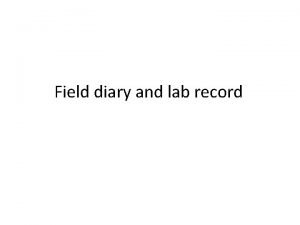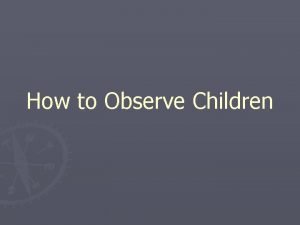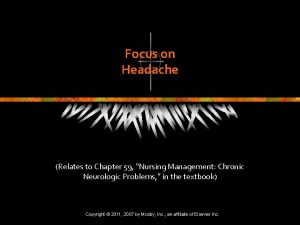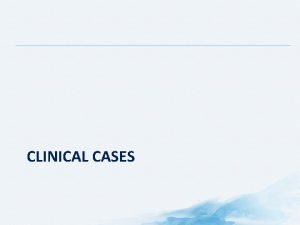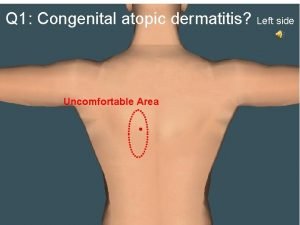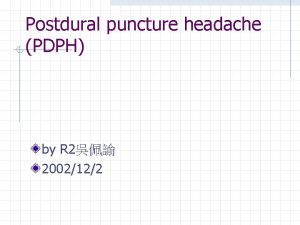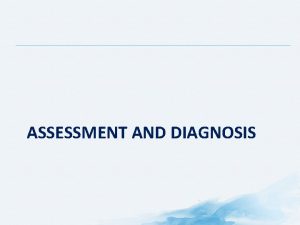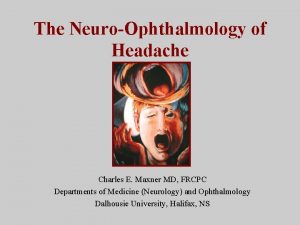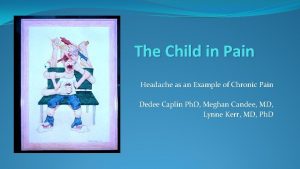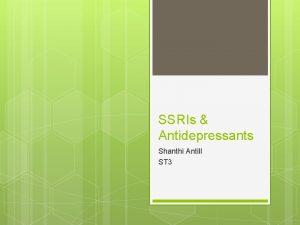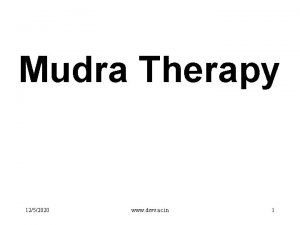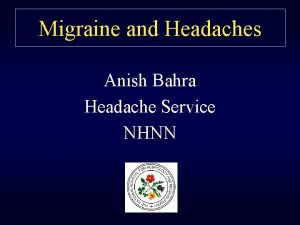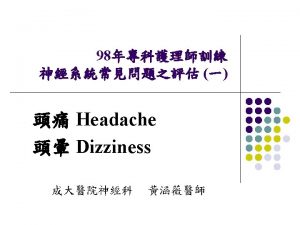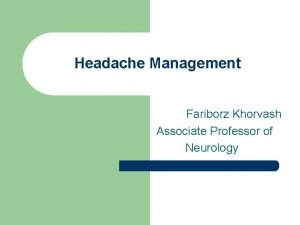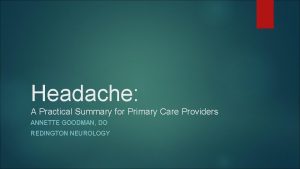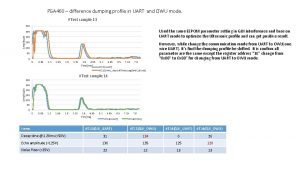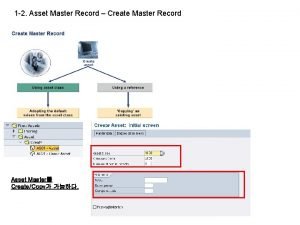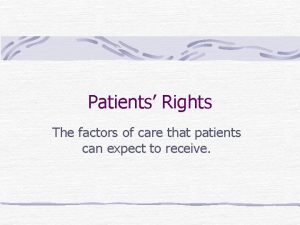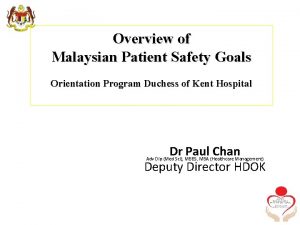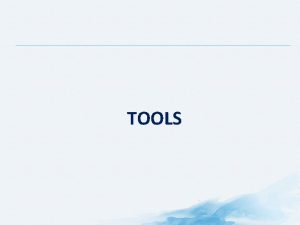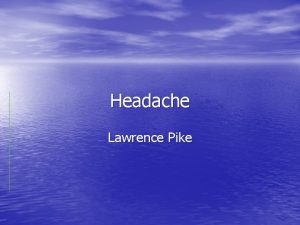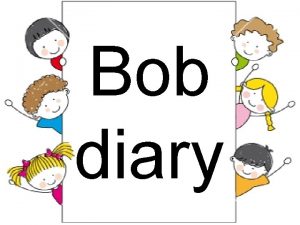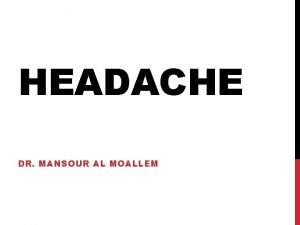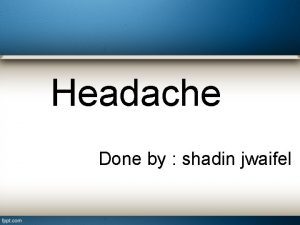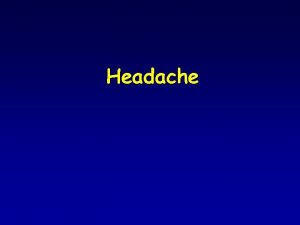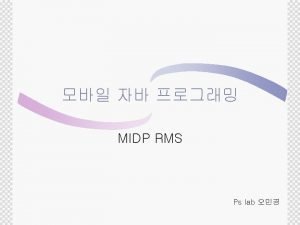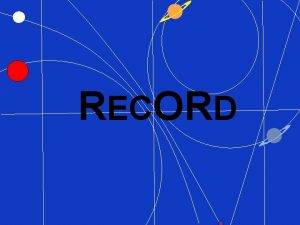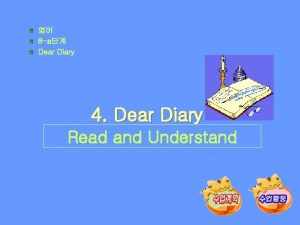TOOLS Headache Diary Patients should record Date time










































- Slides: 42

TOOLS

Headache Diary Patients should record: • Date, time of onset and end • Preceding symptoms • Intensity on scale • Suspected triggers • ANY medication taken, including over -the-counter medication – note dosage taken, how many pills the patient took that day • Relief (complete/partial/none) • Relationship to menstrual cycle American Headache Society, 2004. Available at: http: //www. americanheadachesociety. org/assets/1/7/Book_-_Brainstorm_Syllabus. pdf; National Institute for Health and Care Excellence, 2012. Available at: http: //www. nice. org. uk/CG 150.

Tools to Assess Impact of Migraine Test MIDAS (Migraine Disability Assessment) Comments • 5 -item tool • Scores number of days of inactivity due to migraine in the past 3 months Headache Impact Test™-6 • Covers 6 categories (HIT-6) • Useful in clinical practice and research Headache Needs Assessment (HANA) • 7 -item self-administered tool • Can help identify which patients require treatment Short Form 36® (SF-36®) • 36 items covering physical and mental components of health • Generic measuring tool to identify quality of life issues Stewart WF et al. Neurology. 2001; 56(6 Suppl 1): S 20 -8; Kosinski M et al. Qual Life Res. 2003; 12(8): 963 -74; Cramer JA et al. Headache. 2001; 41(4): 402 -9; Ware, JE Jr. Available at: http: //www. sf-36. org/tools/SF 36. shtml.

Tools to Assess Response to Migraine Therapy Test Comments Migraine Therapy Assessment Questionnaire (MTAQ®) • 9 -item questionnaire • Identifies individuals who may be receiving suboptimal migraine treatment Migraine-ACT (Assessment of Current Therapy) • 4 -item questionnaire • Identifies patients who require a change in their current acute migraine therapy Chatterton ML et al. Headache. 2002; 42(10): 1006 -15; Dowson AJ et al. Curr Med Res Opin. 2004; 20(7): 1125 -35; Kilminster SG et al. Headache. 2006; 46(4): 553 -62.

ID-Chronic Migraine (ID-CM) • New tool that can accurately identify patients with chronic migraine (CM) • Can be used by physicians or patients • Final 12 -item tool asks • How often pain is moderate or severe • How often patient is unusually sensitive to light or sound • How often patient feels nauseated • How often patient worries about missing work, school, or social events because of headaches • Compared to gold standard (semi-structured clinical interview), screening tool had • Sensitivity = 82% • Specificity = 87% • Negative predictive value = 77% • Positive predictive value = 90% Anderson, 2014. Available at: http: //www. medscape. com/viewarticle/831261

ID Migraine™ • • • 3 -item pencil and paper patient questionnaire Sensitivity = 0. 81 (95% CI, 0. 77 -0. 85) Specificity = 0. 75 (95% CI, 0. 64 -0. 84) Test reliability comparable to that of other disease screening tools The following do NOT influence the sensitivity and specificity of ID Migraine: • • Gender Age Presence of comorbid headaches Previous diagnostic status Lipton RB et al. Neurology. 2003; 61: 375 -82.

ID Migraine™ Lipton RB et al. Neurology. 2003; 61: 375 -82.

PCN (Primary Care Network) Screener Do you have headaches that interfere with work, family, or social function? Is your pattern of headache stable for at least 6 months How frequently do you experience headaches? Yes • Think migraine • Plan therapy to match Yes • Think migraine No • Consider detailed workup Frequent How effective is your treatment? Winner P et al. Available at: http: //www. medscape. org/viewarticle/552933 • Consider preventative therapy • Consider medication overuse • Consider secondary headache disorder • Assess acute response, recurrence, coping strategies • Assess medication overuse (>2 to 3 days/week)

Brief Headache Screen – Frequency and Disability How often do you… 1. Get severe headaches that make it difficult to function? 2. Get mild or less severe headaches? 3. Take painkillers or headache relievers? 4. Miss time from work or leisure activities because of headache? Frequency Scale Near daily 3 -4 Days/week 2 Days/week to 2 days/month ≤ 1 Day/month Almost never Maizels M, Burchette R. Headache. 2003; 43(5): 441 -50.

Brief Headache Screen – Treatment • Are you satisfied with your current headache treatment? • Are you taking daily prescription medications to prevent headaches? • If not, would you like to? Maizels M, Burchette R. Headache. 2003; 43(5): 441 -50.

Migraine Impact Assessment Tools • MIDAS (Migraine Disability Assessment) • Ped. MIDAS (Pediatric Migraine Disability Assessment) • Headache Impact Test™-6 (HIT-6) • Headache Needs Assessment (HANA) • Short Form 36 (SF-36®) 1. WHO 2012. Headache disorders. Available at: http: //www. who. int/mediacentre/factsheets/fs 277/en/

MIDAS (Migraine Disability Assessment) • Developed to measure headache-related disability in three areas in the past 3 months • Paid work and education • Household work • Family, social, and leisure activities • Measures number of days missed in these activity due to migraine • Score provides insight into the medical needs of patients and helps health care provider determine appropriate treatment at first consultation Stewart WF et al. Neurology. 2001; 56(6 Suppl 1): S 20 -8.

MIDAS (Migraine Disability Assessment) Score Item 1. On how many days in the last 3 months did you miss work or school because of your headaches? 2. How many days in the last 3 months was your productivity at work/school reduced by half or more because of your headaches? (Do not include days you counted in question 1 where you missed work/school. ) 3. On how many days in the last 3 months did you not do household work (such as housework, home repairs and maintenance, shopping, caring for children and relatives) because of your headaches? 4. How many days in the last 3 months was your productivity in household work reduced by half of more because of your headaches? (Do not include days you counted in question 3 where you did not do household work. ) 5. On how many days in the last 3 months did you miss family, social or leisure activities because of your headaches? _____ Total (questions 1 to 5) A. On how many days in the last 3 months did you have a headache? (If a headache lasted more than one day, count each day. ) B. On a scale of 0 to 10, on average how painful were these headaches? 0 = no pain at all; 10 = pain as bad as it could be) A MIDAS score ≥ 6 indicates disability due to migraine Stewart WF et al. Neurology. 2001; 56(6 Suppl 1): S 20 -8.

MIDAS (Migraine Disability Assessment) Scoring MIDAS Grade Definition MIDAS Score I Little or no disability 0 to 5 II Mild disability 6 to 10 III Moderate disability 11 to 20 IV Severe disability Stewart WF et al. Neurology. 2001; 56(6 Suppl 1): S 20 -8. 21+

HIT – Headache Impact Test • Helps patients communicate the severity of their headache pain to their health care provider • Helps to • Determine impact of headaches on patient’s life • Better communicate the information to the health care provider • Track the patient’s headache history and response to therapy over time

Headache Impact Test™-6 (HIT-6) Score >60 indicates patient is severely impacted or impaired by migraines Kosinski M et al. Qual Life Res. 2003; 12(8): 963 -74.

Headache Needs Assessment (HANA) • • Designed to assess frequency and impact of migraine headaches Brief, self-applied questionnaire Probes seven areas related to living with migraine Can be used as a screening tool to detect potential problems • Primary care physicians could use the HANA to screen patients with migraine for further evaluation • Can help identify candidates for further evaluation and treatment • Advantages • Can select who should be treated • Can increase productivity by ensuring patients who need treatment receive treatment • Can identify the need for aggressive treatment without the usual slow advanced through stepped-care algorithms Cramer JA et al. Headache. 2001; 41(4): 402 -9.

Headache Needs Assessment (HANA) Cramer JA et al. Headache. 2001; 41(4): 402 -9.

Short Form 36 (SF-36®) SF-36® scales measure physical and mental components of health Ware, JE Jr. Available at: http: //www. sf-36. org/tools/SF 36. shtml.

Migraine Treatment Response Assessment Tools • Migraine Therapy Assessment Questionnaire (MTAQ®) • Migraine-ACT (Assessment of Current Therapy) Questionnaire 1. WHO 2012. Headache disorders. Available at: http: //www. who. int/mediacentre/factsheets/fs 277/en/

Migraine Therapy Assessment Questionnaire (MTAQ®) • Identifies migraine sufferers whose migraine management may be suboptimal • Brief survey to identify possible management issues • 9 scaled questions focus on: • Migraine control • Migraine frequency • Time missed from work or school • Satisfaction with treatment • Emergency department use • Total score ranges from 0 to 8 Chatterton ML et al. Headache. 2002; 42(10): 1006 -15.

Migraine Therapy Assessment Questionnaire (MTAQ®) Yes No Item Most times, I get relief from my migraine symptoms within 2 afters after I take my migraine medicine. Most times, I can get back to what I was doing within 2 hours after I take my migraine medication. Most months, I get 3 or more migraines. I take daily medicine to reduce how often I get migraines. I know what may bring on my migraines. Most times, I try not to use my migraine medicines right away. In the past month, I missed some school, work, or other activity because of a migraine. In the past 6 months, I had to go to an emergency or urgent care centre for a migraine. I am satisfied with my migraine treatment. Chatterton ML et al. Headache. 2002; 42(10): 1006 -15.

Migraine-ACT (Assessment of Current Therapy) Questionnaire • Brief questionnaire to identify patients who require a change in their current acute migraine therapy • 4 -item questionnaire • Items pertain to: • Impact of migraine • Global assessment of relief • Consistency of response to medication(s) • Emotional response • Total score ranges from 0 to 4 • One or more “NO” responses may indicate that therapy needs to be changed Dowson AJ et al. Curr Med Res Opin. 2004; 20(7): 1125 -35; Kilminster SG et al. Headache. 2006; 46(4): 553 -62.

Migraine-ACT (Assessment of Current Therapy) Questionnaire Yes No Item When you take your treatment: Does your migraine medication work consistently, in the majority of your attacks? When you take your treatment: Does the headache pain disappear within two hours? When you take your treatment: Are you able to function normally within two hours? When you take your treatment: Are you comfortable enough with your medication to be able to plan your daily activities? Scoring • One or more “NO” answers may indicate the need to change treatment. • An increasing number of “NO” answers indicates increasing treatment needs. Dowson AJ et al. Curr Med Res Opin. 2004; 20(7): 1125 -35; Kilminster SG et al. Headache. 2006; 46(4): 553 -62.

Depression Scales

PHQ-9 Kroenke K et al. J Gen Intern Med. 2001; 16(9): 606 -13.

Hospital Anxiety and Depression Scale A = anxiety; D = depression Zigmond AS, Snaith RP. Acta Psychiatr Scand. 1983; 67: 361 -70.

Hamilton Depression Rating Scale (HAM-D)

Montgomery-Åsberg Depression Rating Scale Montgomery SA, Asberg M. Br J Psychiatry. 1979; 134: 382 -9.

Beck Depression Inventory Beck AT et al. Arch Gen Psychiatry. 1961; 4: 561 -71.

Anxiety Scales

Beck Anxiety Inventory Beck AT et al. J Consult Clin Psychol. 1988; 56(6): 893 -7.

Hamilton Anxiety Rating Scale (HAM-A) Hamilton M. Br J Med Psychol. 1959; 32: 50 -5.

Hospital Anxiety and Depression Scale - Anxiety Question Frequency Score I feel tense or “wound up” Most of the time A lot of the time Occasionally Not at all 3 2 1 0 I get a sort of frightened feeling as if something awful is about to happen Very definitely and quite badly Yes, but not too badly A little, but it doesn’t worry me Not at all 3 2 1 0 Worrying thoughts go through my mind A great deal of the time A lot of the time From time to time, but not often Only occasionally 3 2 1 0 I can sit at ease and feel relaxed Definitely Usually Not often Not at all 0 1 2 3 I get a sort of frightened feeling like “butterflies” in the stomach Not at all Occasionally Quite often Very often 0 1 2 3 I feel restless as I have to be on the move Very much indeed Quite a lot Not very much Not at all 3 2 1 0 I get sudden feelings of panic Very often indeed Quite often Not very often Not often at all 3 2 1 0 Zigmond AS, Snaith RP. Acta Psychiatr Scand. 1983; 67: 361 -70.

Quality of Life Scales

Migraine-Specific Quality of Life Bagley CL et al. Headache. 2012; 52(3): 409 -21.

Headache Disability Inventory Holroyd KA. J Consult Clin Psychol. 2002; 70: 656 -77.

Pain Disability Scale

Pain Disability Index Tait RC, Chibnall JT, Krause S. The Pain Disability Index: psychometric properties. Pain. 1990; 40: 171 -82.

Literature Cited American Headache Society. (2004). Brainstorm. Retrieved June 18, 2015, from http: //www. americanheadachesociety. org/assets/1/7/Book_-_Brainstorm_Syllabus. pdf Assessing the Assessment: Clinical Utility of Currently Available Migraine Assessment Tools. (n. d. ). Retrieved June 18, 2015, from http: //www. medscape. org/viewarticle/552933 Bagley, C. L. , Rendas-Baum, R. , Maglinte, G. A. , Yang, M. , Varon, S. F. , Lee, J. , & Kosinski, M. (2012). Validating Migraine-Specific Quality of Life Questionnaire v 2. 1 in episodic and chronic migraine. Headache, 52(3), 409– 421. http: //doi. org/10. 1111/j. 1526 -4610. 2011. 01997. x Beck, A. T. , Epstein, N. , Brown, G. , & Steer, R. A. (1988). An inventory for measuring clinical anxiety: psychometric properties. Journal of Consulting and Clinical Psychology, 56(6), 893– 897. Beck, A. T. , Ward, C. H. , Mendelson, M. , Mock, J. , & Erbaugh, J. (1961). An inventory for measuring depression. Archives of General Psychiatry, 4, 561– 571. Chatterton, M. L. , Lofland, J. H. , Shechter, A. , Curtice, W. S. , Hu, X. H. , Lenow, J. , … Silberstein, S. D. (2002). Reliability and validity of the migraine therapy assessment questionnaire. Headache, 42(10), 1006– 1015. Cramer, J. A. , Silberstein, S. D. , & Winner, P. (2001). Development and validation of the Headache Needs Assessment (HANA) survey. Headache, 41(4), 402– 409.

Literature Cited (Continued) Dowson, A. J. , Tepper, S. J. , Baos, V. , Baudet, F. , D’Amico, D. , & Kilminster, S. (2004). Identifying patients who require a change in their current acute migraine treatment: the Migraine Assessment of Current Therapy (Migraine-ACT) questionnaire. Current Medical Research and Opinion, 20(7), 1125– 1135. http: //doi. org/10. 1185/030079904125004079 Hamilton, M. (1959). The assessment of anxiety states by rating. The British Journal of Medical Psychology, 32(1), 50– 55. Holroyd, K. A. (2002). Assessment and psychological management of recurrent headache disorders. Journal of Consulting and Clinical Psychology, 70(3), 656– 677. Kilminster, S. G. , Dowson, A. J. , Tepper, S. J. , Baos, V. , Baudet, F. , & D’Amico, D. (2006). Reliability, validity, and clinical utility of the Migraine-ACT questionnaire. Headache, 46(4), 553– 562. http: //doi. org/10. 1111/j. 1526 -4610. 2006. 00403. x Kosinski, M. , Bayliss, M. S. , Bjorner, J. B. , Ware, J. E. , Garber, W. H. , Batenhorst, A. , … Tepper, S. (2003). A six-item short-form survey for measuring headache impact: the HIT-6. Quality of Life Research: An International Journal of Quality of Life Aspects of Treatment, Care and Rehabilitation, 12(8), 963– 974. Kroenke, K. , Spitzer, R. L. , & Williams, J. B. W. (2001). The PHQ-9. Journal of General Internal Medicine, 16(9), 606– 613. http: //doi. org/10. 1046/j. 1525 -1497. 2001. 016009606. x

Literature Cited (Continued 1) Lipton, R. B. , Dodick, D. , Sadovsky, R. , Kolodner, K. , Endicott, J. , Hettiarachchi, J. , … ID Migraine validation study. (2003). A self-administered screener for migraine in primary care: The ID Migraine validation study. Neurology, 61(3), 375– 382. Montgomery, S. A. , & Asberg, M. (1979). A new depression scale designed to be sensitive to change. The British Journal of Psychiatry: The Journal of Mental Science, 134, 382– 389. New Screening Tool for Chronic Migraine. (n. d. ). Retrieved June 18, 2015, from http: //www. medscape. com/viewarticle/831261 Stewart, W. F. , Lipton, R. B. , Dowson, A. J. , & Sawyer, J. (2001). Development and testing of the Migraine Disability Assessment (MIDAS) Questionnaire to assess headache-related disability. Neurology, 56(6 Suppl 1), S 20– 28. Tait, R. C. , Chibnall, J. T. , & Krause, S. (1990). The Pain Disability Index: psychometric properties. Pain, 40(2), 171– 182. The SF Community - SF-36® Health Survey Update. (n. d. ). Retrieved June 18, 2015, from http: //www. sf-36. org/tools/SF 36. shtml Zigmond, A. S. , & Snaith, R. P. (1983). The hospital anxiety and depression scale. Acta Psychiatrica Scandinavica, 67(6), 361– 370.
 Dividend declaration date
Dividend declaration date Dividend eligibility
Dividend eligibility Differentiate field dairy and lab record
Differentiate field dairy and lab record Anecdotal record vs running record
Anecdotal record vs running record Diary entry format
Diary entry format Diary entry tense
Diary entry tense Pediatric headache red flags
Pediatric headache red flags How to apply sick leave in infosys
How to apply sick leave in infosys Headache pain chart
Headache pain chart Headache red flags
Headache red flags Right side headache
Right side headache Pumcture
Pumcture Snoop headache criteria
Snoop headache criteria Migraine hangover symptoms
Migraine hangover symptoms Headache chart
Headache chart Headache
Headache Severe anxiety
Severe anxiety Seizure after effects
Seizure after effects Nursing diagnosis of meningitis slideshare
Nursing diagnosis of meningitis slideshare Jalodar nashak mudra
Jalodar nashak mudra Rasmussen's encephalitis
Rasmussen's encephalitis Anish bahra
Anish bahra Test weber y rinne
Test weber y rinne Snoop headache
Snoop headache Headache
Headache ı have a headache song
ı have a headache song Dr alexander mauskop
Dr alexander mauskop Headache
Headache European headache federation
European headache federation The absolutely true diary of a part time indian themes
The absolutely true diary of a part time indian themes Start time end time and elapsed time
Start time end time and elapsed time Telling time and date
Telling time and date Awareness session invitation
Awareness session invitation Importance of daily time record
Importance of daily time record Record time
Record time Record time
Record time Marking tools in sewing
Marking tools in sewing Life expectancy of sickle cell patients
Life expectancy of sickle cell patients Bed position nursing
Bed position nursing Perimylolysis
Perimylolysis The factors of care that patient can expect
The factors of care that patient can expect Patients rights charter
Patients rights charter Malaysia patient safety goals 2021
Malaysia patient safety goals 2021


